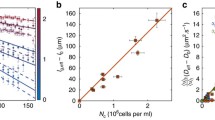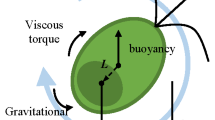Abstract
We describe the behaviour of motile microorganisms (e.g. flagellates) attracted by “gyrotaxis” to a sinking, non-motile particle (e.g. an algal cell). The model is based on the application of Stokes' solution for the flow field around the settling cell. The volume within which the flagellate is attracted to the sinking particle is determined from the trajectories of the flagellate. The model of gyrotaxis has several applications; these include the colonization of sinking marine snow particles with motile microoganisms and suspension feeding by protozoa.
Similar content being viewed by others
References
Alldredge, A. L. and M. W. Silver. 1988. Characteristics, dynamics and significance of marine snow.Prog. Oceanogr. 20, 41–82.
Azam, F. and J. W. Ammerman. 1984. Cycling of organic matter by bacterioplankton in pelagic marine ecosystems: microenvironmental considerations. InFlows of Energy and Material in Marine Ecosystems, M. J. R. Fasham (Ed.), pp. 345–360. New York: Plenum Press.
Batchelor, G. K. 1967.An Introduction to Fluid Dynamics. Cambridge: Cambridge University Press.
Childress, S., M. A. R. Koehl, and M. Miksis. 1987. Scanning currents in Stokes'flow and the efficient feeding of small organisms.J. Fluid Mech. 177, 407–436.
Davis, H. T. 1960.Introduction to Nonlinear Differential and Integral Equations. New York: Dover.
Fenchel, T. 1982a. Ecology of heterotrophic microflagellates. II. Bioenergetics and growth.Mar. Ecol. Prog. Ser. 8, 225–231.
Fenchel, T. 1982b. Ecology of heterotrophic microflagellates. IV. Quantitative occurrence and importance as consumers of bacteria.Mar. Ecol. Prog. Ser. 9, 35–42.
Fenchel, T. 1984. Suspended marine bacteria as a food source. InFlows of Energy and Materials in Marine Ecosystems. M. J. R. Fasham (Ed.), pp. 301–315. New York: Plenum Press.
Fenchel, T. 1986. Protozoan filter feeding.Prog. Protistol. 1, 65–113.
Fenchel, T. 1988. Marine plankton food chains.Ann. Rev. Ecol. Syst. 19, 19–38.
Goldman, J. C. 1984. Conceptual role for microaggregates in pelagic waters.Bull. Mar. Sci. 35, 462–476.
Hansen, J. L. S., M. Olesen and U. Timm. A new method for determining the potential of particle flocculation.Mar. Biol. (submitted).
Happel, J. and H. Brenner. 1965.Low Reynolds Number Hydrodynamics. Dordrecht: Kluwer.
Hawley, N. 1982. Settling velocity distribution of natural aggregates.J. geophys. Res. 87(C12), 9489–9498.
Jackson, G. A. 1987. Physical and chemical properties of aquatic environments. InEcology of Microbial Communities M. Fletcheret al. (Eds), pp. 213–233. Cambridge: Cambridge University Press.
Jackson, G. A. 1989. Simulation of bacterial attraction and adhesion to falling particles in an aquatic environment.Limnol. Oceanogr. 34, 514–530.
Kessler, J. O. 1984. Cyrotactic buoyant convection and spontaneous pattern formation in algal cell cultures. In:Non-equilibrium Co-operative Phenomena in Physics and Related Field, M. G. Velarde (Ed.), pp. 241–248. New York: Plenum Press.
Kessler, J. O. 1985a. Co-operative and concentrative phenomena of swimming microorganisms.Contemp. Phys. 26, 147–166.
Kessler, J. O. 1985b. Hydrodynamics focusing of motile algal cells.Nature 313, 218–220.
Lamb, H. 1945.Hydrodynamics. New York: Dover.
Legier-Visser, M. F., J. G. Mitchell, A. Okubo and J. A. Fuhrman. 1986. Mechanoreception in calanoid copepods: a mechanism for prey detection.Mar. Biol. 90, 529–535.
Levandowsky, M., S. Childress, E. A. Spiegel and S. H. Hunter. 1975. A mathematical model of pattern formation by swimming micro-organisms.J. Protozool. 22, 296–306.
Mitchell, J. G., A. Okubo and J. A. Fuhrman. 1985. Microzones surrounding phytoplankton form the basis for a stratified microbial ecosystem.Nature 316, 58–59.
Mitchell, J. G. 1988.Microplankton live in a standard environment. Ph.D. dissertation, State University of New York, Stony Brook, 233 pp.
Mitchell, J. G., A. Okubo and J. A. Fuhrman. 1990. Gyrotaxis as a new mechanism for generating spatial heterogeneity and migration in microplakton.Limnol. Oceanogr. 35, 123–129.
Monger, B. C. and M. R. Landry. 1990. Direct-interception feeding by marine zooflagellates: the importance of suface and hydrodynamic forces.Mar. Ecol. Prog. Ser. 65, 123–140.
Okubo, A. 1988. Planktonic micro-communities in the sea: biofluid mechanical review. InLecture Notes in Biomathematics (Vol. 77). Community Ecology, A. Hastings (Ed.), pp. 13–24. New York: Springer-Verlag.
Pedley, T. J., N. A. Hill and J. O. Kessler. 1988. The growth of bioconvection patterns in a uniform suspension of gyrotactic micro-organisms.J. Fluid Mech. 195, 223–237.
Pedley, T. J. and J. O. Kessler. 1987. The orientation of spheroidal micro-organisms swimming in a flow field.Proc. R. Soc. Lond. B 239, 47–70.
Pedley, T. J. and J. O. Kessler. 1990. A new continuum model for suspensions of gyrotactic micro-organisms.J. Fluid Mech. 212, 155–182.
Shimeta, J. and P. A. Jumars. 1991. Physical mechanisms and rates of particle capture by suspension feeders.Oceanogr. Mar. Biol. Ann. Rev. 29, 191–257.
Spielman, L. A. 1977. Particle capture from low-speed laminar flows.Ann. Rev. Fluid. Mech. 9, 297–319.
Timm, U. and A. Okubo. 1994. Gyrotaxis: a plume model for self-focusing micro-organisms.Bull. math. Biol. 56, 187–206.
Author information
Authors and Affiliations
Corresponding author
Rights and permissions
About this article
Cite this article
Timm, U., Okubo, A. Gyrotaxis: Interaction between algae and flagellates. Bltn Mathcal Biology 57, 631–650 (1995). https://doi.org/10.1007/BF02461844
Received:
Accepted:
Issue Date:
DOI: https://doi.org/10.1007/BF02461844




